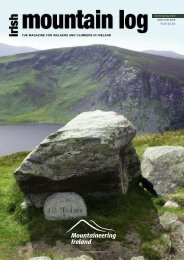Uplands Wild Flowers Article IML101 - Mountaineering Ireland
Uplands Wild Flowers Article IML101 - Mountaineering Ireland
Uplands Wild Flowers Article IML101 - Mountaineering Ireland
Create successful ePaper yourself
Turn your PDF publications into a flip-book with our unique Google optimized e-Paper software.
HELEN LAWLESS<br />
HELEN LAWLESS<br />
LittLe mountain beauties<br />
Following on from last summer’s article on heathers (IML98), this article introduces you to some of the wildflowers commonly<br />
found on the irish mountains in late spring and over the summer. these plants are all found on the damp, acidic grassland,<br />
heaths and blanket bogs that cover most of ireland’s mountain areas. all are small, low-growing plants, but their beauty rewards<br />
the effort required to spot them.<br />
Lousewort with its ragged leaves and hooded,<br />
pale pink flowers, photographed at Keadeen, Co<br />
Wicklow.<br />
Lousewort<br />
Lus an ghiolla Pedicularis sylvatica<br />
Lousewort flowers from April to July and is<br />
one of the first flowers you will come<br />
across in the wetter parts of the hills. It is a<br />
low creeping plant, with ragged reddish<br />
leaves that look a bit like Lollo Rosso<br />
lettuce.<br />
51 Irish Mountain Log<br />
<strong>Wild</strong> flowers of the uplands<br />
Despite its unattractive name, Lousewort<br />
produces beautiful pale-pink flowers, up to<br />
2cm long. Lousewort is a semi-parasitic<br />
plant that attaches to the roots of host<br />
plants (usually grasses and heathers) to<br />
compensate for the poor supply of<br />
nutrients in its bog and heath habitats.<br />
Lousewort was believed to spread lice to<br />
sheep and other animals, and while this is<br />
the origin of the plant’s name, it remains<br />
unproven. However, it has been shown that<br />
Lousewort could possibly be involved in<br />
the transmission of liver fluke, as<br />
Lousewort grows in wet areas where in<br />
winter small snails that can carry liver<br />
fluke embryos cling to plants. These could<br />
be transferred to sheep that graze over the<br />
land. Sheep afflicted by liver fluke are<br />
almost sure to have lice too. 1<br />
tormentil<br />
Néalfartach Potentilla erecta<br />
If there’s one flower you’ll definitely come<br />
across on the Irish hills, it is Tormentil. Its<br />
bright-yellow, four-petalled flowers dot the<br />
slopes from May to September, and often<br />
into October. Tormentil is both widespread<br />
and abundant and will be found growing in<br />
wet grassland as well as on heaths and<br />
bogs. Its flowers are small, typically 7-<br />
11mm in diameter. Despite its small size,<br />
Walkers in the Galtees,<br />
heading towards Galtymore.<br />
Tormentil’s cheerful yellow flowers dot the hills<br />
for almost six months of the year.<br />
and having four petals instead of the usual<br />
five, Tormentil is a member of the Rose<br />
family.<br />
The thick roots of Tormentil contain a lot<br />
of tannin, a plant compound normally<br />
derived from tree bark, that is used<br />
extensively for tanning leather. During the<br />
18 th century, <strong>Ireland</strong> was particularly<br />
Spring 2012<br />
© ZÖE DEVLIN
HELEN LAWLESS<br />
Heath Milkwort growing among grass on the<br />
slopes above Doolough, Co Mayo.<br />
lacking in trees and in 1727 the Irish<br />
Parliament awarded £200 to William Maple<br />
for discovering that leather could be<br />
tanned using Tormentil roots. In 1729,<br />
Maple published his findings in a pamphlet<br />
entitled A Method of Tanning Without Bark.<br />
This contained an illustration of a<br />
Tormentil plant and has the distinction of<br />
being the first illustrated botanical work to<br />
be published in <strong>Ireland</strong>. 2<br />
Tormentil also had a range of traditional<br />
medicinal uses, mainly to do with the<br />
digestive system. Its roots were boiled in<br />
milk and the milk then given to calves and<br />
children to cure them of colic. The name<br />
‘Tormentil’ reflects this, as it comes from<br />
the Latin tormentum, which means both<br />
torment and the pains of colic. 3 Tormentil<br />
is still used in many herbal remedies to<br />
treat digestive problems and toothache.<br />
Heath milkwort<br />
Na deirfiúríní Polygala serpyllifolia<br />
Heath Milkwort is a slender, inconspicuous<br />
plant with dark leaves. It grows principally<br />
in wet heaths, but could also be found in<br />
hill grasslands, growing to a height of about<br />
15cm.<br />
Heath Milkwort flowers from May to<br />
September, but I have come across flowers<br />
as late as December in the Maumturks and<br />
the Wicklow Mountains. Its flowers are<br />
most often deep blue in colour, but you will<br />
also find mauve, pink and even white<br />
versions. These little flowers (5-6mm long)<br />
are really beautiful and best appreciated<br />
through a hand lens.<br />
Milkwort’s colour variations account for<br />
its folk-name, ‘four sisters’, which is<br />
reflected in the plant’s Irish name, na<br />
deirfiúríní. 3 Heath Milkwort is very similar<br />
to Common Milkwort, which is found on<br />
less acidic ground. Heath Milkwort has<br />
lanceolate or spear-shaped narrow leaves.<br />
The lower leaves are always in opposite<br />
pairs (unlike Common Milkwort).<br />
Milkwort’s Latin name, Polygala, means<br />
‘much milk’ and Classical authors<br />
recommended it to nursing mothers for<br />
promoting the flow of milk after childbirth.<br />
However, there seems to be little evidence<br />
of its success in folklore. 4<br />
Heath spotted-orchid<br />
Na circíní Dactylorhiza maculata<br />
Heath Spotted-Orchid is <strong>Ireland</strong>’s most<br />
common orchid5 and one of our most<br />
delightful upland flowers. Heath Spotted-<br />
Orchids will be found from May to August,<br />
growing in damp acid grassland and heath.<br />
Like many of its relatives, Heath Spotted-<br />
Orchid is variable in colour, but the flowers<br />
are most often pale pink with purple<br />
streaks and spots. It has narrow, pointed<br />
leaves, usually with dark spots, hence the<br />
name. Heath Spotted-Orchid is an upright<br />
plant (10-30cm) with a dense flower spike<br />
that is attractive to bees, which in turn<br />
pollinate the flowers. The lower lip of the<br />
flower has three lobes, with the centre lobe<br />
smaller than the other two. This is the<br />
easiest way to distinguish Heath Spotted-<br />
Orchid from the similar Common<br />
Spotted-Orchid. While Heath Spotted-<br />
Orchid prefers acidic ground, the two are<br />
sometimes found side by side, and you may<br />
also come across hybrids.<br />
Orchids are particularly slow-growing<br />
plants and may take several years to reach<br />
flowering stage. Orchid seeds are amongst<br />
the smallest in the plant kingdom. The tiny<br />
seeds, which are scattered by the wind,<br />
have no food reserves. Germination relies<br />
on the presence of a fungus, which the<br />
orchid exploits for nutrients. Orchids are<br />
dormant in winter, with tubers, stems and<br />
buds all underground.<br />
Common butterwort<br />
Bodán meascáin Pinguicula vulgaris<br />
Common Butterwort is one of our most<br />
distinctive upland plants – its rosette of<br />
yellow-green leaves (about 5cm across)<br />
clings to the ground in a star shape.<br />
Common Butterwort is found on wet<br />
Helen Lawless<br />
Hillwalking, Access & Conservation Officer<br />
The beautiful upright spikes of Heath Spottedorchid,<br />
growing below Ballineddan, Co Wicklow.<br />
heaths and bogs, usually on bare ground<br />
and where water seeps from crags and<br />
rocks.<br />
The violet flowers of Common<br />
Butterwort appear between May and July<br />
each year, as a single flower (about 1cm<br />
across) on a leafless stem of 5-10cm high.<br />
.....Continued next page ➤<br />
The bright yellow-green leaves of Common<br />
Butterwort, growing in their distinctive star shape<br />
on the lower slopes of Ben Bury, Co Mayo.<br />
Spring 2012 Irish Mountain Log 52<br />
CLÍONA NÍ BHRÉARTÚIN<br />
HELEN LAWLESS
© ZÖE DEVLIN (www.wildflowersofireland.net)<br />
Butterwort, like Sundew (below),<br />
survives in a nutrient-poor environment by<br />
supplementing its food supply with an<br />
insect-based diet. Butterwort’s tongueshaped<br />
leaves are covered in microscopic<br />
glands that exude a sticky substance. If the<br />
glands are touched by a drop of rain, or a<br />
grain of sand, nothing happens, but if they<br />
come in contact with any nitrogenous<br />
material such as the body of an insect, the<br />
glands discharge an acid fluid that<br />
dissolves the insect. The resulting solution,<br />
which includes mineral salts, nitrates and<br />
phosphates, is then absorbed by the plant.<br />
The edges of Butterwort leaves are curled<br />
slightly inwards; if an insect alights near<br />
the margins, the leaf slowly curls a bit<br />
more, bringing additional glands in contact<br />
with the prey and thus hastening its<br />
absorption. 6<br />
A related species, Large-flowered<br />
Butterwort (Pinguicula grandiflora), is<br />
found mainly in Kerry and west Cork. Its<br />
rosette of leaves can be 10cm or more in<br />
diameter, with a flower up to 2cm across.<br />
53 Irish Mountain Log<br />
<strong>Wild</strong> flowers of the uplands<br />
Close-up of Round-leaved Sundew with trapped insect. This plant often grows on bare peat.<br />
The spur at the back of the flower is<br />
notably longer than on Common<br />
Butterwort. Large-flowered Butterwort is<br />
not found in Britain; it is one of our<br />
Lusitanian species, with its nearest location<br />
in the mountains of northern Spain and<br />
southern France.<br />
A third species, Pale Butterwort<br />
(Pinguicula lusitanica), is found mainly in<br />
the west of <strong>Ireland</strong>. It has small, greyish<br />
rosettes (1-3cm wide) and much smaller,<br />
pale pink flowers. 7<br />
Butterwort is also known as bog violet<br />
and in Ulster is known as St Patrick’s Staff,<br />
due to the resemblance of the shape of the<br />
flower to a staff. It was said that one of the<br />
flowers sprang up wherever St Patrick’s<br />
own staff touched the ground on his travels<br />
over the bogs. 3<br />
In common with other plants such as Bog<br />
Asphodel and Sundew which grow in the<br />
same habitat, Butterwort was believed to<br />
cause ill-health in sheep and cattle.<br />
Butterwort was used a substitute for<br />
rennet in cheese-making, and the name<br />
Butterwort comes from the plant’s ability<br />
to curdle milk. 2<br />
Round-leaved sundew<br />
Druchtín móna Drosera rotundifolia<br />
The small white flower of Round-leaved<br />
Sundew opens only briefly in sunshine, and<br />
it is more often seen in bud form. The<br />
plant’s appearance and its dietary habits<br />
are more remarkable than its flower. Like<br />
Butterwort, Sundew is an insectivorous<br />
plant. Sundews are found on wet heaths<br />
and bogs (often on bare peat or amongst<br />
Sphagnum mosses) at low altitude. The<br />
plants can be very small, and due to their<br />
reddish colour are at first difficult to spot.<br />
Round-leaved Sundew has circular leaves<br />
(up to 1cm across) that are hairy – ‘all<br />
whiskery like a bee’s leg’ as a Connemara<br />
man described them to Robert Lloyd<br />
Praeger. 6 The ‘hairs’ are tentacles that<br />
secrete sticky, digestive juices as in the<br />
Butterwort, but they are also<br />
extraordinarily responsive to animal<br />
substances, closing in around the prey till<br />
the leaf is like a shut fist.<br />
Praeger observed that Sundews seemed<br />
to be more efficient hunters than the<br />
Butterworts, with their leaves showing<br />
plenty of trapped insects, not only little<br />
ones, but sometimes a small dragonfly or<br />
even a wasp. 6<br />
Like some of the other flowers<br />
mentioned earlier, it is well worth the effort<br />
The more unusual Oblong-leaved Sundew is<br />
found mainly in the west, as in this example from<br />
the Poisoned Glen, Co Donegal.<br />
Spring 2012<br />
HELEN LAWLESS
of getting down low, and getting your knees wet, to<br />
have a good look at this fascinating plant. A hand<br />
lens, or even the magnifying lens on a compass,<br />
will bring out its vivid colours and stunning detail.<br />
The glistening droplet at the end of each tentacle<br />
was mistaken for dew and early observers<br />
assumed that this plant, unlike almost all others,<br />
was capable of retaining its dew in full sunlight. So<br />
the Sundew got its name, and a reputation for<br />
magical properties. 1<br />
Irish folklore records show Sundew’s reputation<br />
as a cure for asthma and whooping cough. 4 Under<br />
its Latin name, Drosera, it is also a commonly used<br />
homeopathic remedy for a dry cough.<br />
There are two less common Sundew species<br />
found mainly in the west of <strong>Ireland</strong>: Oblong-leaved<br />
Sundew (Drosera intermedia) and the larger Great<br />
Sundew (Drosera anglica), both of which have<br />
oblong leaves.<br />
Find out more<br />
In the same way that the Irish mountains, while<br />
not the highest in the world, are rich in their scenic<br />
quality, the flowering plants that grow on our hills,<br />
while mainly small, are amongst the most beautiful<br />
we have. Many have also made ingenious<br />
adaptations to cope with life in harsh and nutrientpoor<br />
environments.<br />
Having a little knowledge about the plants we<br />
see will add to the joy of a day on the hills. There’s<br />
no better time to share this information with<br />
others than over the summer while these plants<br />
are in flower.<br />
This article has covered a few flowers you are<br />
likely to come across. For those who would like to<br />
learn more, there are some excellent online guides<br />
to Irish wildflowers, most notably Zoë Devlin’s<br />
www.wildflowersofireland.net and Jenny<br />
Seawright’s www.irishwildflowers.ie.<br />
Thanks to Clíona ní Bhréartúin, Dr Mary Tubridy<br />
and Faith Wilson for feedback on this article, and to<br />
Zoë Devlin for providing some of the photographs.<br />
References<br />
1 Reader’s Digest Field Guide to the <strong>Wild</strong><br />
<strong>Flowers</strong> of Britain (1981)<br />
2 Oxford Dictionary of Plant-Lore, by Roy<br />
Vickery (1995)<br />
3 Irish <strong>Wild</strong> Plants: Myths, Legends & Folklore,<br />
by Niall Mac Coitir (2006)<br />
4 Medicinal Plants in Folk Tradition, by David E<br />
Allen & Gabrielle Hatfield (2004)<br />
5 <strong>Wild</strong>flowers of <strong>Ireland</strong>: A Personal Record, by<br />
Zoë Devlin (2011)<br />
6 The Way That I Went, by Robert Lloyd Praeger<br />
(first published 1937)<br />
7 <strong>Wild</strong> Plants of the Burren and the Aran Islands,<br />
by Charles Nelson (1999) ■<br />
5 minute interview<br />
Colin Gibbon – climber, outdoor enthusiast<br />
Colin Gibbon is an avid climber and outdoor enthusiast. He is the head<br />
of Shielbaggan Outdoor Education Centre in New Ross, Co Wexford, and<br />
he is also a member of BOS (Bord Oiliúint Sléibhe).<br />
What did you do for your last holiday?<br />
Two weeks skiing in Chamonix<br />
Where is your next holiday to be?<br />
Family holiday to the Scilly Isles<br />
If you could climb any mountain what would it be?<br />
Salathe wall on El Capitan<br />
Why do you love walking in the Irish hills?<br />
Great vistas, because there are no trees<br />
Where is your favourite place to walk in <strong>Ireland</strong>?<br />
Hook Head or Mweelrea<br />
Where is your favourite place outside of <strong>Ireland</strong>?<br />
Acadia National Park, Maine<br />
What is your favourite piece of outdoor equipment?<br />
Waterproof Canon camera<br />
What is your favourite hill food?<br />
Malt loaf<br />
Have you ever been lost?<br />
Oh yeah!<br />
Have you ever been scared in the mountains?<br />
Yes. When exposed to a savage rockfall in the Dru Couloir, Chamonix<br />
What does adventure mean to you?<br />
When you can’t just say ‘I’ve had enough’ and go home<br />
Water bottle or bladder system?<br />
Water bottle. I have passed a certain age<br />
Frosties or muesli?<br />
Neither<br />
Beer or lager?<br />
Lager<br />
Who do you most admire in the outdoor world?<br />
Ranulph Fiennes. Because anything is possible<br />
Who has inspired you most in the outdoor world?<br />
Robert Park – a teacher in school who got me into the outdoors<br />
What is the greatest threat to walking and climbing in <strong>Ireland</strong>?<br />
People with the unshakable belief that it is okay to walk a dog anywhere<br />
Spring 2012 Irish Mountain Log 54













